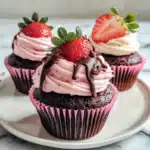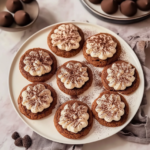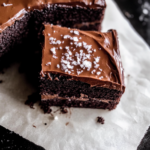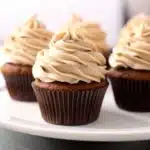Chocolate espresso cake is more than just dessert—it’s a rich, flavorful experience that combines two of life’s greatest pleasures: chocolate and coffee. I’m Mary, known around Bath as “The Pudding Lady,” and my passion for pudding began in my mother’s pantry—where flour floated like snow and sticky tins of golden syrup lined every shelf. I was the little girl sneaking spoonfuls of sugar and hovering near the oven door, waiting for cakes to rise and caramelize.
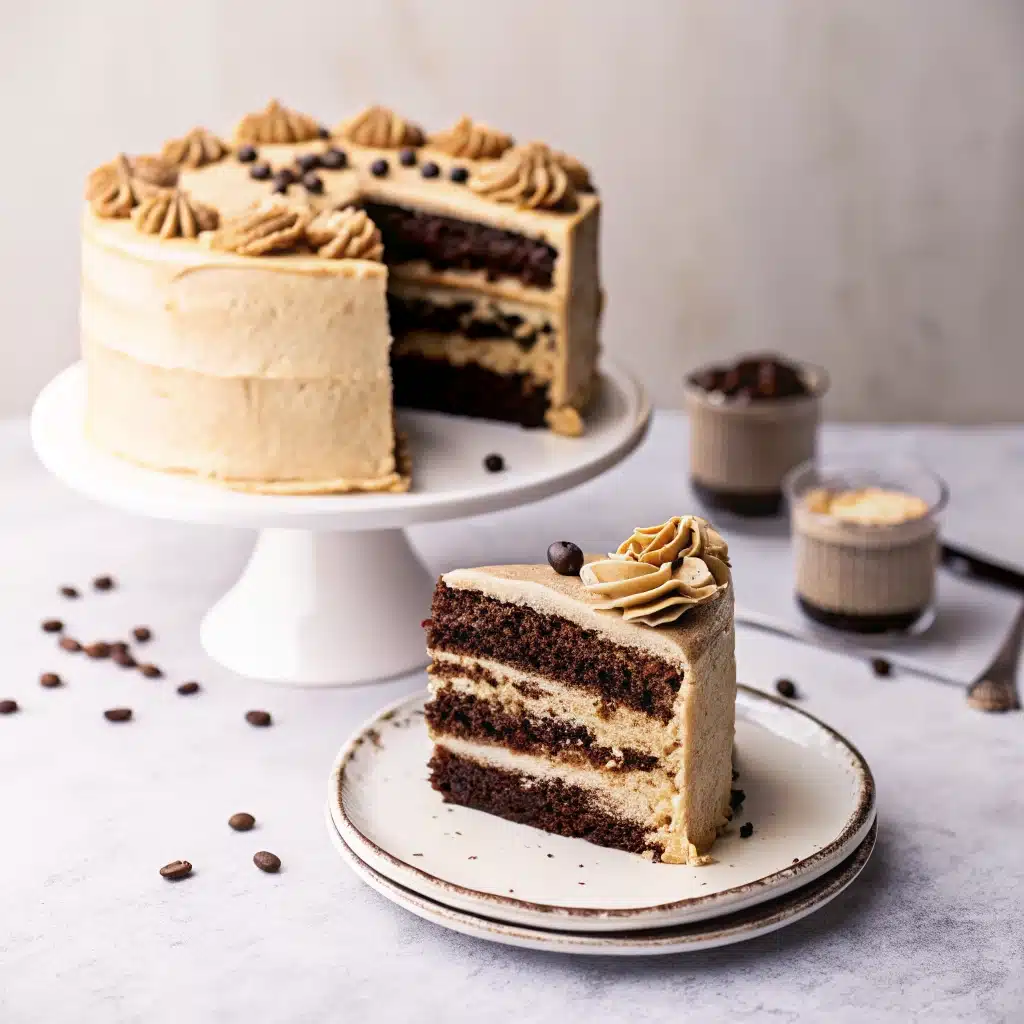
Though I never trained as a pastry chef (too headstrong and curious, really), I found my way through baking. My kitchen filled with warm treacle puddings, jam-soaked sponges, and dark chocolate cakes that brought people together. Over the years, I began sharing my creations at school fêtes and village fairs until someone asked me to teach. That simple question led to my quiet weekend pudding club—just six seats, plenty of tea, and the comforting scent of sugar and spice in the air.
Now, one of the most requested recipes I share is this chocolate espresso cake. It’s a decadent treat where espresso deepens the chocolate flavor, transforming a classic into something unforgettable. In this guide, I’ll show you how to choose the best espresso type, how much to add, and how to balance the bitterness for the perfect result. Whether you’re using instant espresso powder or freshly brewed shots, this recipe is adaptable and beginner-friendly.
You’ll also find answers to common baking questions like: How much espresso powder should I use in a chocolate cake? and What’s the best way to blend coffee into batter? This article will give you everything you need to master the chocolate espresso cake and bake it like a pro.
Table of Contents
What Is Chocolate Espresso Cake?
Understanding the Flavor Profile of Chocolate Espresso Cake
Chocolate espresso cake is more than just a chocolate cake with a hint of coffee; it’s a bold, rich fusion of flavors. The espresso acts as a flavor enhancer—deepening the richness of chocolate without overpowering it. The result is a moist, dense cake with layers of bold flavor that linger on the tongue. The coffee flavor doesn’t dominate but instead supports the chocolate, making it taste darker, deeper, and more complex.
This is why you’ll often see espresso or coffee added to chocolate desserts, even if coffee isn’t the focus. The two ingredients share similar bitter notes, which work together beautifully when baked.
| Component | Role in Flavor |
|---|---|
| Cocoa powder | Adds rich, dark chocolate taste |
| Espresso powder | Intensifies the chocolate flavor |
| Dark chocolate chunks | Enhances texture and depth |
| Butter & oil combo | Keeps the cake moist and luscious |
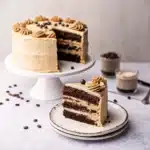
Chocolate Espresso Cake
- Total Time: 55 minutes
- Yield: 10 slices 1x
Description
A decadent, rich chocolate cake infused with bold espresso flavor—perfect for chocolate and coffee lovers alike.
Ingredients
- 1 3/4 cups all-purpose flour
- 3/4 cup unsweetened cocoa powder
- 2 cups sugar
- 2 teaspoons baking soda
- 1 teaspoon baking powder
- 1/2 teaspoon salt
- 2 large eggs
- 1 cup buttermilk
- 1/2 cup vegetable oil
- 1 cup hot espresso or strong coffee
- 1 teaspoon vanilla extract
Instructions
- Preheat oven to 350°F (175°C). Grease and flour two 9-inch round cake pans.
- In a large bowl, whisk together flour, cocoa powder, sugar, baking soda, baking powder, and salt.
- Add eggs, buttermilk, oil, and vanilla. Mix until well combined.
- Gradually stir in the hot espresso until batter is smooth (it will be thin).
- Divide batter evenly between prepared pans.
- Bake for 30–35 minutes, or until a toothpick inserted in the center comes out clean.
- Let cakes cool in pans for 10 minutes, then transfer to wire racks to cool completely.
Notes
Frost with your favorite chocolate ganache or buttercream. For an extra kick, sprinkle espresso powder over the top.
- Prep Time: 20 minutes
- Cook Time: 35 minutes
- Category: Dessert
- Method: Baking
- Cuisine: American
Nutrition
- Serving Size: 1 slice
- Calories: 410
- Sugar: 32g
- Sodium: 300mg
- Fat: 18g
- Saturated Fat: 5g
- Unsaturated Fat: 12g
- Trans Fat: 0g
- Carbohydrates: 58g
- Fiber: 3g
- Protein: 5g
- Cholesterol: 40mg
Why Coffee Enhances Chocolate in Baking
There’s real science behind why chocolate and coffee work so well together. Chocolate contains hundreds of flavor compounds, and coffee helps highlight many of them—especially the earthy, bitter, and roasted notes. The acidity in espresso also cuts through the fat in chocolate-based batters, balancing out sweetness and creating a more complex bite.
Using just a teaspoon or two of espresso powder in a chocolate cake can completely transform its flavor. It’s one of the easiest ways to turn a simple cake into a gourmet dessert. You can see this method used in other recipes like our Chocolate Raspberry Cake or Mini Chocolate Cakes, where subtle flavor enhancements make a huge difference.
Stay tuned—next up, we’ll dig into the core ingredients that make a chocolate espresso cake truly unforgettable.
Key Ingredients in a Chocolate Espresso Cake
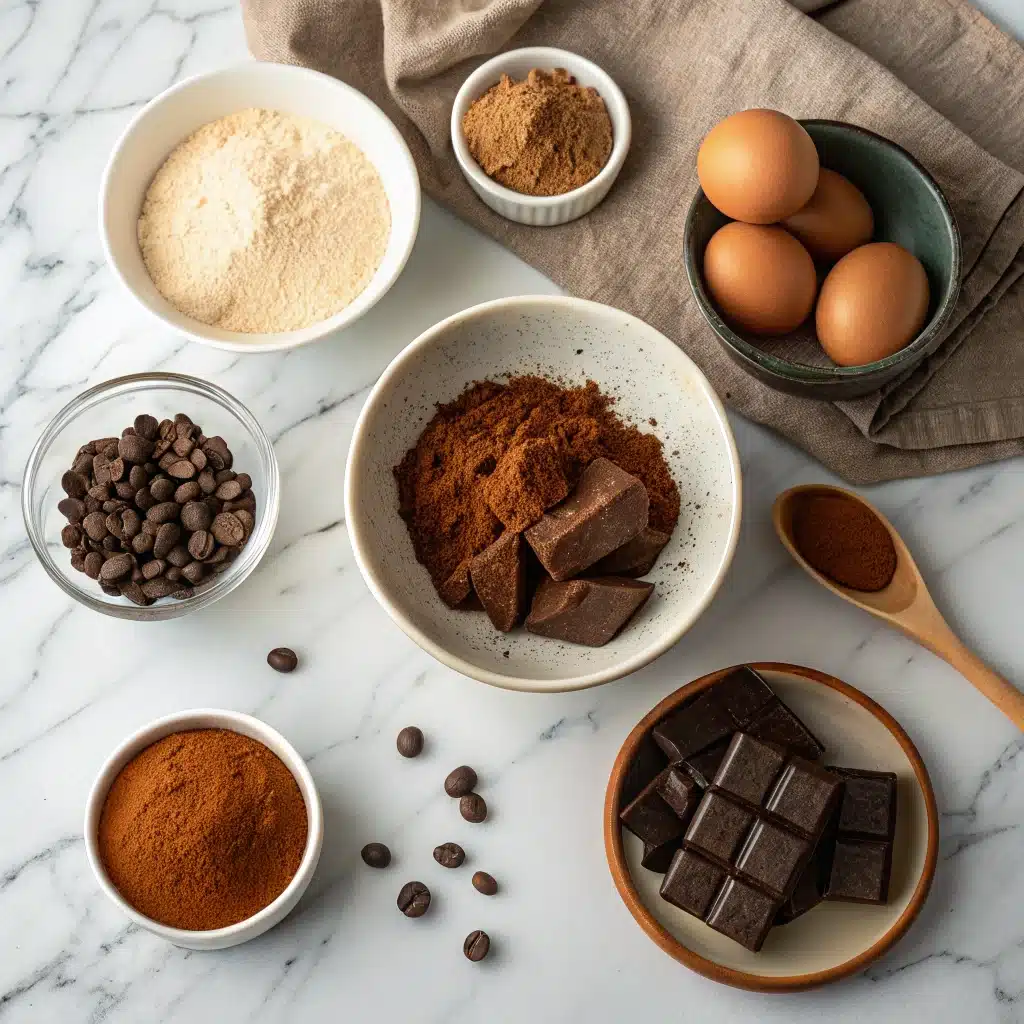
The Role of Cocoa Powder, Dark Chocolate, and Espresso
When it comes to baking the perfect chocolate espresso cake, the ingredients you choose make all the difference. This cake isn’t just about throwing chocolate and coffee together—it’s about using each component to build bold, rich flavor.
Cocoa Powder
This is the base of every great chocolate cake. Use Dutch-processed cocoa powder for a smooth, deep chocolate taste, or natural cocoa for a slightly more acidic flavor. The quality of cocoa directly affects how intense your chocolate espresso cake turns out.
Dark Chocolate
To create that extra-rich texture and boost chocolate depth, dark chocolate is essential. Go for 60–70% cacao chocolate bars or chips, which melt beautifully into the batter and give your cake that irresistible fudgy interior.
Espresso Powder
Now here’s where the real magic happens. A small amount of espresso powder dramatically enhances the chocolate. It doesn’t make your cake taste like coffee—instead, it intensifies the chocolate flavor and brings out those rich, earthy undertones that define a true chocolate espresso cake. Typically, just 1–2 teaspoons are enough for a full batter.
| Ingredient | Why It Matters | Best Option |
|---|---|---|
| Cocoa powder | Builds rich chocolate base | Dutch-process or natural |
| Dark chocolate | Adds depth, moisture, and texture | 60–70% cacao |
| Espresso powder | Enhances chocolate without overpowering | Instant espresso or brewed shot |
Don’t miss our Heavenly Chocolate Cheesecake Trifle for another dessert that layers rich chocolate and subtle coffee notes.
Best Espresso Powder or Coffee Types to Use in Chocolate Espresso Cake
There are several ways to add espresso to a chocolate espresso cake, depending on what form of coffee you prefer or have available.
- Instant Espresso Powder – The easiest and most consistent choice for baking. It dissolves quickly and blends evenly. Add it directly to the dry ingredients.
- Brewed Espresso – Rich in flavor and great for bold cakes. Reduce liquid elsewhere in the recipe if you add more than a couple tablespoons.
- Instant Coffee Granules – Weaker than espresso powder but still effective. Increase the amount slightly if substituting.
- Espresso Shots (machine-made) – Use sparingly (1–2 tbsp) to avoid changing batter consistency. Great for enhancing the liquid component.
Whether you’re aiming for a delicate mocha profile or bold espresso notes, selecting the right type of coffee ingredient ensures your chocolate espresso cake comes out flavorful every time.
You can also experiment with more international flair—check out our Dubai Chocolate Recipe for bold fusion cake ideas that also use coffee tones.
How to Make a Chocolate Espresso Cake From Scratch
Step-by-Step Baking Instructions
Making a homemade chocolate espresso cake may sound fancy, but it’s surprisingly easy once you understand the process. With the right ingredients and timing, you’ll create a show-stopping dessert that’s dense, moist, and packed with deep chocolate and espresso flavor.
Here’s a foolproof recipe to get you started:
Ingredients:
| Dry Ingredients | Wet Ingredients |
|---|---|
| 1 ¾ cups all-purpose flour | 2 large eggs |
| ¾ cup unsweetened cocoa | 1 cup buttermilk |
| 1 ½ tsp baking powder | ½ cup vegetable oil |
| 1 tsp baking soda | 1 tsp vanilla extract |
| ½ tsp salt | 1 cup brewed espresso (cooled) |
| 2 tsp espresso powder | 1 ¾ cups granulated sugar |
Instructions:
- Prep the oven: Preheat to 350°F (175°C). Grease and line two 8-inch round cake pans with parchment paper.
- Mix dry ingredients: In a large bowl, sift together flour, cocoa powder, baking powder, baking soda, salt, and espresso powder.
- Combine wet ingredients: In another bowl, whisk eggs, sugar, oil, vanilla, and buttermilk until smooth. Stir in cooled espresso.
- Combine mixtures: Slowly add the dry ingredients to the wet mixture, stirring until just combined. Avoid overmixing—this keeps the chocolate espresso cake tender.
- Bake: Divide batter between the pans. Bake for 28 to 32 minutes, or until a toothpick inserted into the center comes out clean.
- Cool: Allow the cakes to cool in the pans for 10 minutes before transferring them to a wire rack to cool completely.
This base is rich, balanced, and full of espresso-kissed chocolate flavor. For more mini dessert inspiration, don’t miss our Mini Chocolate Cakes.
Mixing Techniques for Rich Texture and Deep Flavor
Achieving a deep chocolate flavor and moist crumb in a chocolate espresso cake depends on how you mix your ingredients. These simple tricks can have a big impact:
- Sift the cocoa powder and flour to avoid lumps and ensure even mixing.
- Add espresso powder to the dry mix—this guarantees even distribution of flavor.
- Don’t skip buttermilk or sour cream (if substituting). The acidity enhances both texture and flavor depth.
- Use room temperature ingredients—especially eggs and buttermilk—for a smoother, more even batter.
Pro tip: Want a denser cake? Add 1 tbsp of sour cream or Greek yogurt for extra richness.
Using these baking techniques will make your chocolate espresso cake bakery-worthy every single time.
Chocolate Espresso Frosting and Toppings
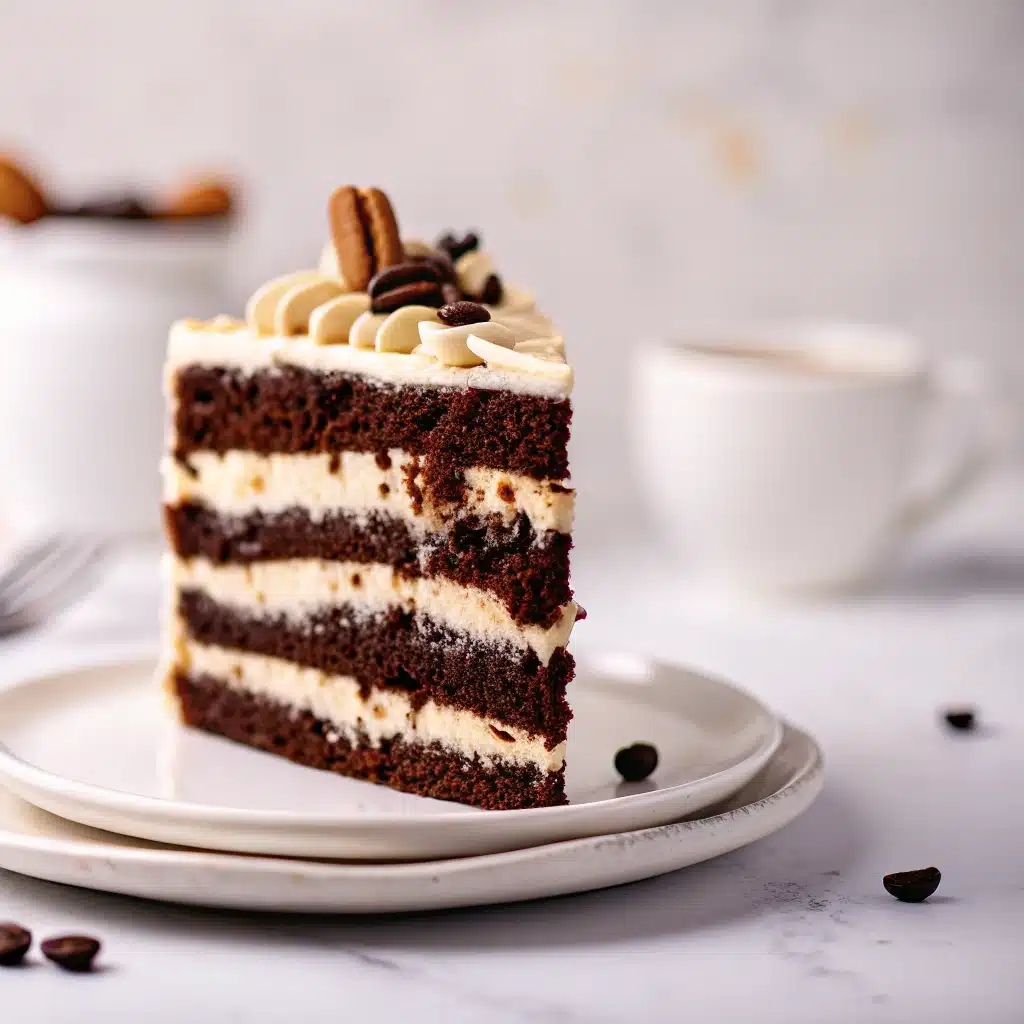
Espresso Buttercream, Ganache, or Mocha Glaze Options
The right frosting doesn’t just sit on top of your cake—it enhances every bite. For a chocolate espresso cake, the frosting should complement the rich chocolate base while bringing in more coffee flavor. Here are the top choices:
1. Espresso Buttercream Frosting
This classic is creamy, smooth, and just sweet enough. The key is to use instant espresso powder, dissolved in a tiny bit of hot water, to give the frosting that signature mocha finish.
Espresso Buttercream Recipe:
| Ingredient | Quantity |
|---|---|
| Unsalted butter | 1 cup (softened) |
| Powdered sugar | 3–4 cups |
| Espresso powder | 2 tsp (dissolved) |
| Vanilla extract | 1 tsp |
| Heavy cream/milk | 2–3 tbsp (as needed) |
Whip the butter until fluffy, then add in the sugar slowly. Mix in the espresso and vanilla, adjusting the consistency with cream as needed.
2. Chocolate Ganache with Espresso
For a more indulgent, glossy finish, chocolate ganache is unbeatable. Heat 1 cup heavy cream until steaming, then pour over 8 oz chopped dark chocolate and 1 tsp espresso powder. Let it sit for 3 minutes, then whisk smooth. Let cool slightly before pouring over the cake for a dramatic drip effect.
3. Mocha Glaze
Looking for a lighter topping for a single-layer chocolate espresso cake? Try a simple mocha glaze. Mix powdered sugar, brewed espresso, and a touch of cocoa powder until it’s pourable. It’s ideal for loaf cakes or bundts.
For more creative cake finishes, explore our Opera Cake, where coffee-forward fillings and glossy layers truly shine.
Creative Toppings: Chocolate Curls, Coffee Beans, and Sea Salt
Toppings don’t just add visual appeal—they enhance flavor and texture too. Whether you’re dressing up a celebration cake or making something for brunch, these topping ideas bring the wow factor:
- Chocolate curls or shards: Use a vegetable peeler on a dark chocolate bar to create beautiful, elegant curls. Chill them before placing on top.
- Espresso beans (whole or chopped): Add crunch and extra coffee aroma. Use chocolate-covered ones for sweetness.
- Dusting of cocoa or espresso powder: A subtle finish that hints at what’s inside.
- Coarse sea salt: Enhances the bittersweet notes in the cake—especially great when paired with ganache.
- Toasted nuts: Crushed hazelnuts or almonds add crunch and balance.
Here’s a quick idea table for toppings based on the finish:
| Frosting Type | Suggested Toppings |
|---|---|
| Espresso Buttercream | Chocolate curls, cocoa dust, sea salt |
| Ganache | Espresso beans, sea salt, nuts |
| Mocha Glaze | Powdered sugar, shaved chocolate |
Decorate just before serving to keep everything fresh and visually appealing. With the right frosting and toppings, your chocolate espresso cake goes from delicious to unforgettable.
Variations and Customizations
Vegan and Gluten-Free Chocolate Espresso Cake Options
Whether you’re baking for dietary restrictions or just want a plant-based treat, you can easily adapt a chocolate espresso cake without sacrificing flavor or texture.
Vegan Chocolate Espresso Cake
Replace dairy and eggs with plant-based alternatives while maintaining a rich, moist crumb. Here’s how:
- Buttermilk substitute: Mix 1 cup plant-based milk (like almond or soy) with 1 tbsp vinegar or lemon juice. Let sit for 10 minutes.
- Egg substitute: Use flax eggs (1 tbsp flaxseed meal + 3 tbsp water per egg), or commercial egg replacers.
- Butter substitute: Use vegan butter or neutral oils like avocado or sunflower.
- Dark chocolate: Make sure it’s dairy-free; many brands offer vegan 70% cacao bars.
Flavor tip: Add a little coconut sugar or maple syrup for added depth, which pairs beautifully with espresso.
Want more ideas? Discover great plant-based dessert inspiration with our Vegan Chocolate Cake and Flourless Chocolate Cake (Vegan).
Gluten-Free Chocolate Espresso Cake
For gluten-free versions of the classic chocolate espresso cake, just make a few substitutions:
- Use a 1:1 gluten-free flour blend that includes xanthan gum for structure.
- Almond flour can also add richness, though it changes the texture (best used with part oat flour).
- Reduce liquid slightly if your flour blend absorbs more moisture.
Always test your batter consistency—it should be pourable but not too thin.
Using Instant Espresso, Brewed Coffee, or Espresso Shots
Let’s talk about customizing the coffee component of your chocolate espresso cake. Different forms of espresso bring different flavor intensities and moisture levels.
| Type of Coffee Used | Flavor Strength | Moisture Impact | Best Use Case |
|---|---|---|---|
| Instant espresso powder | High | Low | Best for dry mix; bold mocha flavor |
| Brewed espresso | Moderate–high | Adds moisture | Use with reduced other liquids |
| Espresso shots (machine) | Very high | Slight moisture | Use sparingly (1–2 tbsp) |
| Instant coffee granules | Mild | Minimal | Substitute if espresso unavailable |
🔎 Tip: If you’re using brewed espresso, reduce other liquid ingredients (like milk) slightly so your cake doesn’t become too soft or gummy.
Want to try a chocolate-coffee fusion with a fruity twist? Check out our Chocolate Raspberry Cake for creative flavor inspiration.
Baking Tips and Common Mistakes to Avoid
How Much Espresso Powder to Add to Chocolate Cake
The biggest question bakers ask is: How much espresso should I use in a chocolate cake?
When it comes to a bold yet balanced chocolate espresso cake, here are the standard amounts based on your method:
| Type of Espresso | Recommended Amount (per 8-inch cake) |
|---|---|
| Espresso powder | 1½ to 2 tsp |
| Instant espresso | 2 tsp |
| Brewed espresso | ¼ to ½ cup |
| Espresso shot | 1 to 2 tbsp |
These amounts enhance the chocolate without turning your dessert into a full-on coffee cake. The key is to let the espresso complement the cocoa, not overpower it.
✅ Pro Tip: Dissolve espresso powder in a small amount of hot water before adding it to your wet ingredients. This boosts flavor absorption and avoids gritty spots.
Troubleshooting Texture, Flavor, and Dryness Issues
Even experienced bakers can run into trouble with chocolate espresso cake. Here’s a list of common baking mistakes and how to avoid them:
1. Cake Is Too Dry
- Problem: Overbaking or too little fat/liquid.
- Fix: Always check for doneness at the earliest time listed in the recipe. Use buttermilk, sour cream, or even a touch of mayonnaise to add moisture.
2. Coffee Flavor Isn’t Noticeable
- Problem: Not enough espresso or it wasn’t well mixed.
- Fix: Use high-quality espresso powder or a strong brew. Mix it thoroughly into your batter or frosting. You can also boost flavor by dusting the cake with espresso powder post-bake.
3. Bitter Aftertaste
- Problem: Using too much espresso or low-quality cocoa.
- Fix: Stick with 1–2 teaspoons of espresso powder. Use Dutch-process cocoa and a balanced sweetener (like brown sugar) to mellow bitterness.
4. Cake Collapses After Baking
- Problem: Overmixing or too much leavening.
- Fix: Mix the batter only until combined, and measure your baking powder/soda carefully.
Baking is part art, part science—but with these tips, your chocolate espresso cake will come out perfectly rich, moist, and aromatic every time.
Looking for a chocolate dessert with similar intensity but a different twist? Don’t miss our indulgent Tiramisu Brownies.
Serving and Pairing Ideas
Best Ways to Serve Chocolate Espresso Cake
How you serve your chocolate espresso cake makes a huge difference in presentation and flavor impact. Whether it’s a birthday dessert or a casual after-dinner treat, these ideas will take your cake from simple to stunning.
1. Serve at Room Temperature
Let the cake sit out for 20–30 minutes after refrigeration. This allows the chocolate and espresso notes to bloom fully on the palate.
2. Add a Scoop of Ice Cream
Pair with vanilla bean, mocha, or salted caramel ice cream for a temperature and flavor contrast. The cool creaminess enhances the cake’s richness.
3. Top with Whipped Cream or Espresso Foam
A swirl of lightly sweetened whipped cream balances the deep chocolate notes. Finish with a dusting of cocoa or a sprinkle of instant espresso powder for a polished touch.
4. Layer in a Trifle
Cube your chocolate espresso cake and layer it with mascarpone cream and crushed espresso cookies in a glass bowl. Great for repurposing leftover cake creatively.
| Serving Style | Perfect For |
|---|---|
| Room temperature | Best flavor release |
| With ice cream | Elegant dessert plate presentation |
| Whipped topping | Casual dinners or brunch |
| Trifle layering | Parties or leftover repurposing |
Looking for more indulgent cake ideas? Check out our Romantic Chocolate and Strawberry Cupcakes for a dreamy dessert option.
Perfect Drink Pairings: Coffee, Wine, and Milk
The bold flavor of chocolate espresso cake makes it an ideal match for a variety of beverages. Here’s what to pour alongside:
1. Coffee or Espresso
It may sound obvious, but it works—pair like with like. Brew a medium roast or a shot of espresso to match the cake’s depth. Want contrast? Try a sweetened cappuccino.
2. Red Wine
A bold red, such as Cabernet Sauvignon or Zinfandel, pairs beautifully with it. These wines complement the richness of both chocolate and espresso.
3. Milk or Milk Alternatives
A cold glass of whole milk cuts through the richness and offers creamy relief. For dairy-free options, oat milk works best for its creaminess and neutral flavor.
4. Irish Cream or Coffee Liqueur
Serve in a shot glass or drizzle over the cake for an adults-only twist. A splash of Kahlúa or Baileys in the frosting is also a great flavor booster.
| Beverage | Why It Works |
|---|---|
| Espresso | Matches and intensifies flavor |
| Red wine | Adds elegance and depth |
| Milk (dairy/oat) | Refreshes and lightens |
| Coffee liqueurs | Adds boozy warmth |
Whether it’s dessert at home or a dinner party finale, these serving tips will make your chocolate espresso cake even more unforgettable.
Storage, Freezing, and Reheating Instructions
How to Store the Cake for Freshness
A properly stored chocolate espresso cake maintains its flavor and moisture for several days. Here’s how to keep your cake tasting fresh:
At Room Temperature
- If unfrosted, wrap the cooled cake layers tightly in plastic wrap.
- Store in an airtight container in a cool, dry place for up to 2 days to maintain freshness.
- Avoid sunlight and humidity, which can alter the texture.
Refrigerated
- For frosted cakes, refrigeration is best—especially if using buttercream, ganache, or dairy-based fillings.
- Store in a cake box or covered container for up to 5 days.
- Let it sit at room temperature for 30–40 minutes before serving to bring out full espresso and chocolate flavors.
| Storage Method | Duration | Notes |
|---|---|---|
| Room temperature | 1–2 days | Best for unfrosted cakes |
| Refrigerator | 3–5 days | Great for frosted cakes |
| Freezer | 1–2 months | Wrap well to avoid freezer burn |
Freezing Tips and How to Reheat Without Drying It Out
Freezing your chocolate espresso cake is a fantastic option for meal prep or saving leftovers.
To Freeze the Cake:
- Wrap individual slices or entire layers in plastic wrap, then cover with aluminum foil for added freshness.
- Place in a freezer-safe bag or container.
- Label with date and type (especially helpful if you bake often).
You can also freeze the frosted cake, but note: buttercream freezes well, while whipped cream toppings may not hold up as nicely.
Reheating Instructions:
- Let slices thaw in the fridge overnight or at room temperature for a few hours.
- To warm it slightly (and enhance that gooey, chocolatey interior), microwave for 10–15 seconds.
- For oven warming, preheat to 300°F and warm for 5–7 minutes, loosely covered in foil to retain moisture.
✅ Pro Tip: Brush thawed cake slices with a bit of brewed espresso or simple syrup before reheating. It enhances the flavor and keeps the cake extra moist.
Whether you’re baking ahead or saving a slice for later, proper storage ensures your chocolate espresso cake remains rich, bold, and totally irresistible.
Fore more recipes follow me in Facebook, medium and Pinterest
How much espresso powder to add to chocolate cake?
For a rich, bold flavor in your chocolate espresso cake, add 1½ to 2 teaspoons of espresso powder. This amount intensifies the chocolate without turning the cake into a coffee-dominant dessert. Always dissolve the powder in a warm liquid or mix it with the dry ingredients to ensure even distribution.
How much espresso to add to chocolate cake?
If you’re using brewed espresso, stick with ¼ to ½ cup. This gives your cake a deep, roasted flavor and added moisture. Be sure to reduce other liquids (like milk or water) slightly to maintain the proper batter consistency.
How much instant espresso to add to chocolate cake?
Instant espresso is strong, so a little goes a long way. Use 2 teaspoons for a noticeable yet balanced flavor in a standard 8-inch chocolate espresso cake. Dissolve it in warm milk, cream, or water before adding to your wet mix.
How to add espresso to chocolate cake?
You can add espresso in multiple forms:
Espresso powder: Mix with dry ingredients or dissolve in liquid first.
Brewed espresso: Mix with wet ingredients, replacing a portion of milk or water.
Espresso shots: Add 1–2 tablespoons directly to the batter or frosting.
Each method offers a unique flavor profile, so choose based on the intensity you want in your chocolate espresso cake.
Can I add espresso to chocolate cake?
Absolutely. In fact, adding espresso is one of the best ways to elevate a traditional chocolate cake. Espresso deepens the cocoa flavor and adds complexity. Whether you’re using powder, brewed coffee, or espresso shots, it’s a great way to enhance your chocolate espresso cake without overwhelming it with coffee flavor.

